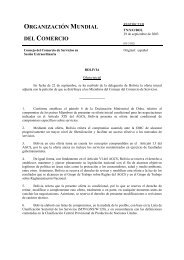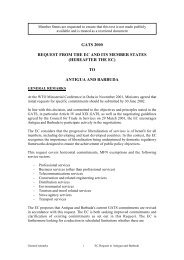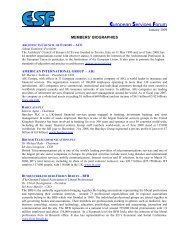- Page 1 and 2: 200. 00 100. 0.00 50.00 120 Interna
- Page 3 and 4: This report is also available in Fr
- Page 5 and 6: Acknowledgements This publication h
- Page 7 and 8: 4.4 Financial services 145 4.5 Comp
- Page 9 and 10: 7. Foreign affiliates trade in serv
- Page 11 and 12: 4.5 Textiles Table II.62 Textile ex
- Page 13 and 14: 2.2.1 Trade in commercial services
- Page 15 and 16: xiv
- Page 17 and 18: WORLD TRADE DEVELOPMENTS I The surg
- Page 19: WORLD TRADE DEVELOPMENTS I per cent
- Page 23 and 24: WORLD TRADE DEVELOPMENTS I 2. Trade
- Page 25 and 26: WORLD TRADE DEVELOPMENTS I Table I.
- Page 27 and 28: WORLD TRADE DEVELOPMENTS I 3. Leadi
- Page 29 and 30: WORLD TRADE DEVELOPMENTS I Table I.
- Page 31 and 32: WORLD TRADE DEVELOPMENTS I 4. Bilat
- Page 33 and 34: WORLD TRADE DEVELOPMENTS I Table I.
- Page 35 and 36: WORLD TRADE DEVELOPMENTS I Table I.
- Page 37 and 38: WORLD TRADE DEVELOPMENTS I Table I.
- Page 39 and 40: WORLD TRADE DEVELOPMENTS I Table I.
- Page 41 and 42: WORLD TRADE DEVELOPMENTS I Table I.
- Page 43 and 44: WORLD TRADE DEVELOPMENTS I Table I.
- Page 45 and 46: WORLD TRADE DEVELOPMENTS I 6. Least
- Page 47 and 48: WORLD TRADE DEVELOPMENTS I Table I.
- Page 49 and 50: WORLD TRADE DEVELOPMENTS I 7. Forei
- Page 52 and 53: II. II. MERCHANDISE TRADE BY PRODUC
- Page 54 and 55: Office and telecom equipment A mark
- Page 56 and 57: Extra-EU exports also experienced g
- Page 58 and 59: 1. Overview Table II. 1 World merch
- Page 60 and 61: Table II.3 Share of agricultural pr
- Page 62 and 63: Table II.11 Share of textiles in tr
- Page 64 and 65: Table II.14 Imports of agricultural
- Page 66 and 67: Table II.15 Leading exporters and i
- Page 68 and 69: Table II.17 Imports of agricultural
- Page 70 and 71:
Table II.19 Imports of food of sele
- Page 72 and 73:
Table II.21 Exports of food of sele
- Page 74 and 75:
3. Fuels and mining products Table
- Page 76 and 77:
Table II.25 Imports of fuels of sel
- Page 78 and 79:
Table II.27 Imports of fuels of sel
- Page 80 and 81:
Table II.29 Trade in manufactures o
- Page 82 and 83:
Table II.30 (continued) Imports of
- Page 84 and 85:
Table II.32 Exports of manufactures
- Page 86 and 87:
4.1. Iron and steel Table II.34 Exp
- Page 88 and 89:
Table II.36 Leading exporters and i
- Page 90 and 91:
Table II.38 Leading exporters and i
- Page 92 and 93:
4.3. Office and telecom equipment T
- Page 94 and 95:
Table II.41 (continued) Imports of
- Page 96 and 97:
Table II.43 Exports of office and t
- Page 98 and 99:
4.3.1. EDP equipment Table II.45 Im
- Page 100 and 101:
Table II.46 Leading exporters and i
- Page 102 and 103:
Table II.48 Imports of EDP and offi
- Page 104 and 105:
Table II.49 (continued) Imports of
- Page 106 and 107:
Table II.51 Exports of telecommunic
- Page 108 and 109:
4.3.3. Integrated circuits and elec
- Page 110 and 111:
Table II.54 Leading exporters and i
- Page 112 and 113:
Table II.56 Imports of integrated c
- Page 114 and 115:
Table II.58 Imports of automotive p
- Page 116 and 117:
Table II.59 Leading exporters and i
- Page 118 and 119:
Table II.61 Imports of automotive p
- Page 120 and 121:
Table II.63 Textile imports of sele
- Page 122 and 123:
Table II.63 (continued) Textile imp
- Page 124 and 125:
Table II.65 Textile exports of sele
- Page 126 and 127:
4.6. Clothing Table II.67 Clothing
- Page 128 and 129:
Table II.68 (continued) Clothing im
- Page 130 and 131:
Table II.70 Clothing exports of sel
- Page 132 and 133:
III. III. TRADE IN COMMERCIAL SERVI
- Page 134 and 135:
Construction Building infrastructur
- Page 136 and 137:
per cent), legal, accounting, manag
- Page 138 and 139:
1. Overview Table III.1 World trade
- Page 140 and 141:
Table III.4 Leading exporters and i
- Page 142 and 143:
Table III.5 (continued) Trade in tr
- Page 144 and 145:
Table III.7 Leading exporters and i
- Page 146 and 147:
Table III.8 (continued) Trade in tr
- Page 148 and 149:
4. Other commercial services Table
- Page 150 and 151:
Table III.11 Trade in other commerc
- Page 152 and 153:
4.1. Communications services Table
- Page 154 and 155:
4.2. Construction Table III.16 Worl
- Page 156 and 157:
4.3. Insurance services Table III.1
- Page 158 and 159:
4.4. Financial services Table III.2
- Page 160 and 161:
4.5. Computer and information servi
- Page 162 and 163:
4.5.1 Computer services Table III.2
- Page 164 and 165:
Table III.32 Receipts of royalties
- Page 166 and 167:
Table III.35 Exports of other busin
- Page 168 and 169:
4.8. Personal, cultural and recreat
- Page 170 and 171:
4.8.1 Audiovisual services Table II
- Page 172 and 173:
IV. METADATA This chapter details t
- Page 174 and 175:
Table IV.1 (continued) Composition
- Page 176 and 177:
2. Definitions and methodology 2.1
- Page 178 and 179:
Table IV.2 (continued) Products 85
- Page 180 and 181:
2.2.1 Trade in commercial services
- Page 182 and 183:
2.2.2 Foreign affiliates trade in s
- Page 184 and 185:
3. Specific notes for selected econ
- Page 186 and 187:
4. Statistical sources Most frequen
- Page 188 and 189:
Appendix Table A1 World merchandise
- Page 190 and 191:
APPENDIX 175
- Page 192 and 193:
Table A2 (continued) Network of wor
- Page 194 and 195:
Table A4 Merchandise trade by selec
- Page 196 and 197:
Table A6 World merchandise exports
- Page 198 and 199:
Table A6 (continued) World merchand
- Page 200 and 201:
Table A7 World merchandise imports
- Page 202 and 203:
Table A7 (continued) World merchand
- Page 204 and 205:
Table A8 World exports of commercia
- Page 206 and 207:
Table A8 (continued) World exports
- Page 208 and 209:
Table A9 (continued) World imports
- Page 210 and 211:
APPENDIX 195
- Page 212 and 213:
Table A10 (continued) Network of wo
- Page 214 and 215:
Table A10 (continued) Network of wo
- Page 216 and 217:
Table A10 (continued) Network of wo
- Page 218 and 219:
Table A12 Merchandise trade by regi
- Page 220 and 221:
Table A14 Merchandise trade by regi
- Page 222 and 223:
Table A16 Merchandise trade of Euro
- Page 224 and 225:
APPENDIX 209
- Page 226 and 227:
Table A18 (continued) Merchandise t
- Page 228 and 229:
Table A19 (continued) Merchandise t
- Page 230 and 231:
Table A20 (continued) Merchandise t
- Page 232 and 233:
Table A21 (continued) Merchandise t
- Page 234 and 235:
Table A22 (continued) Merchandise t
- Page 236 and 237:
Table A23 (continued) Merchandise t
- Page 238 and 239:
Table A24 (continued) Domestic expo
- Page 240 and 241:
Table A25 (continued) Merchandise t
- Page 242 and 243:
Table A26 (continued) Merchandise t
- Page 244 and 245:
Table A27 (continued) Merchandise t
- Page 246 and 247:
Table A28 (continued) Merchandise t
- Page 248 and 249:
Table A30 Export prices of Germany,
- Page 250 and 251:
World maps Map 1 Composition of geo
- Page 252 and 253:
Map 3 Ratio of exports and imports
- Page 254 and 255:
Notes ………………………















